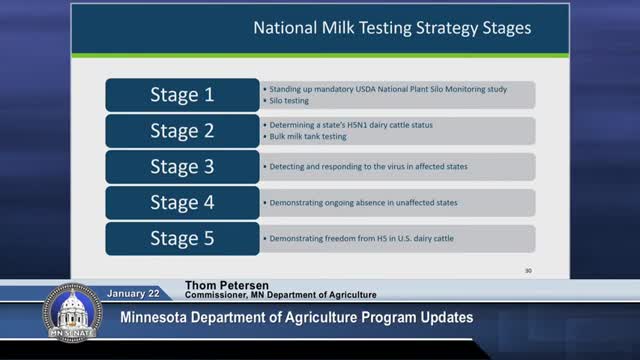Minnesota Agriculture Department prepares for potential dairy virus outbreak amid California crisis
January 22, 2025 | 2025 Legislature MN, Minnesota
This article was created by AI summarizing key points discussed. AI makes mistakes, so for full details and context, please refer to the video of the full meeting. Please report any errors so we can fix them. Report an error »

On January 22, 2025, the Minnesota Senate's Committee on Agriculture, Veterans, Broadband, and Rural Development convened to address pressing issues affecting the state's agricultural sector, particularly concerning biosecurity measures in dairy and poultry farming. The meeting highlighted the ongoing threat posed by avian influenza and its potential impact on Minnesota's dairy farms, which number around 1,700.
Commissioner Peterson reported that Minnesota had experienced nine cases of avian influenza in dairy farms over the summer, a situation that mirrors a more severe outbreak in California, where approximately 700 out of 900 dairy farms have been affected. This alarming trend raises concerns about the crossover effects between dairy and poultry farms, as the virus can significantly impact milk production and pose risks to neighboring poultry operations.
The committee discussed the importance of biosecurity measures and the financial support provided to farmers to mitigate the risks associated with these outbreaks. Peterson emphasized the need for robust funding, noting that Minnesota's agricultural emergency account had previously held $4 million to address such crises. However, the account is currently strained due to the frequency of claims related to wildlife depredation, which has left farmers waiting for compensation until the next fiscal year.
In addition to avian influenza, the committee touched on other animal health concerns, including African swine fever and foot-and-mouth disease. Peterson assured members that the Department of Agriculture is actively working with the USDA to secure cooperative agreements that would allow for reimbursement of expenses incurred during outbreaks.
The meeting also addressed the importance of public health measures, including the provision of personal protective equipment (PPE) for farm workers, which has seen high uptake in Minnesota. This initiative is crucial in safeguarding both the health of farm workers and the integrity of the agricultural supply chain.
As the committee concluded, it was clear that the discussions underscored the interconnectedness of animal health, agricultural productivity, and economic stability in rural Minnesota. The ongoing challenges posed by animal diseases necessitate continued vigilance and support from both state and federal agencies to ensure the resilience of the agricultural sector. The committee's next steps will likely involve further discussions on funding and resource allocation to address these critical issues effectively.
Commissioner Peterson reported that Minnesota had experienced nine cases of avian influenza in dairy farms over the summer, a situation that mirrors a more severe outbreak in California, where approximately 700 out of 900 dairy farms have been affected. This alarming trend raises concerns about the crossover effects between dairy and poultry farms, as the virus can significantly impact milk production and pose risks to neighboring poultry operations.
The committee discussed the importance of biosecurity measures and the financial support provided to farmers to mitigate the risks associated with these outbreaks. Peterson emphasized the need for robust funding, noting that Minnesota's agricultural emergency account had previously held $4 million to address such crises. However, the account is currently strained due to the frequency of claims related to wildlife depredation, which has left farmers waiting for compensation until the next fiscal year.
In addition to avian influenza, the committee touched on other animal health concerns, including African swine fever and foot-and-mouth disease. Peterson assured members that the Department of Agriculture is actively working with the USDA to secure cooperative agreements that would allow for reimbursement of expenses incurred during outbreaks.
The meeting also addressed the importance of public health measures, including the provision of personal protective equipment (PPE) for farm workers, which has seen high uptake in Minnesota. This initiative is crucial in safeguarding both the health of farm workers and the integrity of the agricultural supply chain.
As the committee concluded, it was clear that the discussions underscored the interconnectedness of animal health, agricultural productivity, and economic stability in rural Minnesota. The ongoing challenges posed by animal diseases necessitate continued vigilance and support from both state and federal agencies to ensure the resilience of the agricultural sector. The committee's next steps will likely involve further discussions on funding and resource allocation to address these critical issues effectively.
View full meeting
This article is based on a recent meeting—watch the full video and explore the complete transcript for deeper insights into the discussion.
View full meeting
